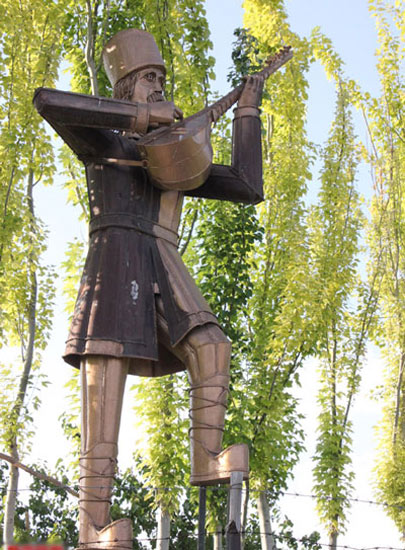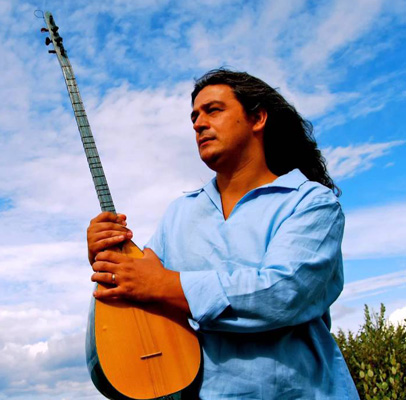As part of its own project “Explore South Azerbaijan”, APA presents an article by Mohammed Rahmanifar “Ashugs – chanters of the common culture of Azerbaijan”.
Khoy city: An impregnable fortress of Azerbaijanism and freedom trench
URMIA: Beating heart of Azerbaijanism
How does the Tehran regime Persianize Turkish toponyms in South Azerbaijan?
A common culture, along with a common language and history, is one of the components that unite a group of people in the form of a nation. In other words, each people has its own culture, which has both elements common with other peoples and distinctive elements that emphasize the identity of this people.
The values, beliefs, traditions and elements that make up the culture of the nation as a whole do not arise overnight and do not disappear overnight when some parts of the nation are forcibly divided, for example, due to changes in political boundaries as a result of wars. What we call a common culture is the product of centuries, even millennia.
According to the Turkmenchay Treaty of 1828, the historical territory of Azerbaijan was divided into two parts. Since that day, both parts of Azerbaijan have been under the rule of different states, and even subjected to cultural aggression of the regimes ruling in them. Tsarism and communism in Northern Azerbaijan, the regimes of the Persian Pahlavi dynasty and the Islamic Republic in Southern Azerbaijan systematically tried to destroy Azerbaijani culture and impose their culture on Azerbaijanis. These regimes dealt a heavy blow to the rich culture of Azerbaijanis, but none of them succeeded in destroying this culture.
Ashug art has been one of the components of Azerbaijani culture since ancient times. Traces of this art can be seen in petroglyphs (stone cuts) dating back millennia BC, as well as in the most ancient Turkic epics. In the ancient epics of the Azerbaijani people, such as "Dede Gorgud" and "Koroglu", where the heroes could not solve the problem with the power of the sword, they managed to solve problems with the help of saz.
Ashugs should be considered one of the most important components of Azerbaijani folklore. Throughout history, they have preserved Azerbaijani culture not only in royal palaces, but also among the people. Unlike some court poets and artists, the verses of the ashugs were much closer to the language of the common people, which made it easier for them to communicate with the common people. This situation persisted in later times, as a result of which the connection between the ashugs and the common people was preserved.

Grave of Dede ashug Heste Qasim (1684-1760) in the village of Tikmedash in South Azerbaijan
As we have already said, ashug art is considered a common value of Azerbaijanis. However, our article is devoted to the topic of the preservation of Azerbaijani culture among the Turks of South Azerbaijan, so in it we will devote a place to ashug art in South Azerbaijan. Ashugs of South Azerbaijan played a unique role in the preservation of Turkic culture.
Ashug creativity of South Azerbaijan constitutes a large and saturated part of the literature of division or Hijran literature of South Azerbaijan. Hijran literature originates from the division of Azerbaijan into two parts according to the Turkmenchay Treaty. This literature, the main theme of which is longing for brothers, the pain of separation, protest against separation and the preservation of the desire for unity, has been a common theme in the work of Azerbaijani poets and ashugs over the past two hundred years.
The ashugs of South Azerbaijan have always tried to describe this pain in their speeches. Thanks to their poems and songs about the division of Azerbaijan, about this tragic event, the Turks of South Azerbaijan did not forget this terrible pain and that they have brothers and sisters separated from them by the will of fate.
In a country where history is falsified and the historical truth is hidden from people, these cases of ashugs acquire a unique significance.
The history textbooks for students in schools in South Azerbaijan do not even mention the common identity, history, language and culture of the Azerbaijani Turks living on both sides of the Araz River, and the media of this country do their best to portray the peoples on both sides of the river as foreign. In this situation, the ashugs of South Azerbaijan, on the one hand, tried to preserve the culture of this people, on the other hand, to preserve the spirit of unity of the peoples separated from each other.
As the author of these lines, I learned about the division of our Azerbaijan, the pangs of separation, the desire of Azerbaijanis on both sides of the Araz to reunite not from textbooks, but from the words of the ashug song heard in childhood at a wedding. Although 30-35 years have passed since then, I still remember the touching performance of that ashug.
Despite the pressure of the Iranian state, one of the reasons for the protection of ashug art is that it is a folk art, it is supported by the people. In other words, the main source of income for the ashugs was the people, ordinary people. Until recently, ashugs sang at most weddings and celebrations held in the cities and villages of Azerbaijan. On the one hand, they introduced people to the culture and history of Azerbaijan, and on the other hand, they were a source of income for the ashugs.
That is why poetry suffered little from the pressure of the Iranian regime, rather than other types of art common in South Azerbaijan. But ashug art did not escape pressure from the Iranian central government. Not only was this art never supported or encouraged by the Iranian government, activists in the field often faced many hardships. This art, its representatives, has no place either in the official press or even in official structures, except for a few amateurs who are invited on certain days to radio and television to promote the government.

Monument "Demir Ashug" - a symbol of the ashug art of South Azerbaijan
The monument was erected in 1975 in the Shah-gol park in Tabriz. After some time, it was dismantled, and for a long time it was stored in the warehouse of the Tabriz municipality. Now it has been re-installed, but this place is far from the city.
The peak of pressure from Iranian government officials on Azerbaijani ashug art came in 1998. In November 1998, by order of the representative of the spiritual leader of Iran Khamenei in Tabriz, the Azerbaijani saz and the American flag were burned.
This issue cannot be analyzed only from the point of view of the fact that the mullahs are against music. Although in the early days of the Islamic Revolution in Iran (1979-1981) the mullahs were openly opposed to music, in later years they became more tolerant, and even Iran's official state radio and television began broadcasting music daily.
Considering that in 1998 the Turks of South Azerbaijan had more opportunities to obtain cultural, social, economic and political rights, they made great efforts to preserve their identity and culture, it becomes obvious that the burning of the Azerbaijani saz, in addition to the burning of the American flag in Tabriz had a political rather than a religious aspect. This, in turn, testifies to the undeniable role of the Azerbaijani ashugs in preserving the identity, language, history, culture of the Turks of South Azerbaijan and the fear of enemies before these Azerbaijani masters of saz and words.
The pressure on the ashugs of South Azerbaijan continued in subsequent years, but it could not prevent the continuation of their activities. With the expansion of the wave of activities of the Turks of South Azerbaijan over the past thirty years, the interest in studying this ancient and genuine art of Azerbaijan has increased significantly among young people.
On the other hand, activists in this sphere were able to maintain their independence to some extent. True, weddings and various celebrations began to be held differently, especially in large cities, and ashugs began to participate less in these ceremonies. However, the development of media technologies and social networks has provided them with new opportunities. On the other hand, despite all the prohibitions, the ashugs of South Azerbaijan still manage to periodically hold concerts, participate in mass ceremonies or celebrations, and this indicates that they still occupy a place in the cultural life of society.

Ashug Chengiz Mehdipur, who has undeniable merits in the expansion of ashug art in modern South Azerbaijan
Despite the fact that the ashug art of the Turks of South Azerbaijan still retains a certain traditional aspect, some of those who are active in this area have been able to keep up with the new generation. This novelty concerns both music and words. The younger generation of Turks, and especially the activists of the national movement of South Azerbaijan, are waiting for the ashugs to innovate in this area instead of repeating centuries-old dastans and musical works, to talk about the current difficulties of society. And in general, we see how people like works that describe the suffering and rights of the people.
Of course, like other areas of art, the art of ashugs is not just an expression of human pain and suffering. As is known, epic verses, dastans and compositions form an important part of this art. In modern South Azerbaijan, some ashugs were able to create valuable works based on rich epic experience. They not only attract the attention of the people, but also play a big role in raising the patriotic spirit.

Ozan Araz Elsyas leads the national struggle of the Turks of South Azerbaijan with words and words and conveys the heroic spirit of youth
In general, it can be said that the very existence of ashug art in South Azerbaijan indicates that the ancient culture of the Azerbaijani Turks is alive in this region to this day. There are many factors pointing to the cultural unity of the Azerbaijani Turks and their common culture, but ashug art, as an almost rooted tradition, is the most obvious factor pointing to this unity. This immortal art of the Azerbaijani Turks is alive and active, both in the past and today, despite all pressures. Wherever Azerbaijani ashugs live, Azerbaijani culture also lives.
Muhammad Rahmanifar




 ANALYSIS'>
ANALYSIS'>


